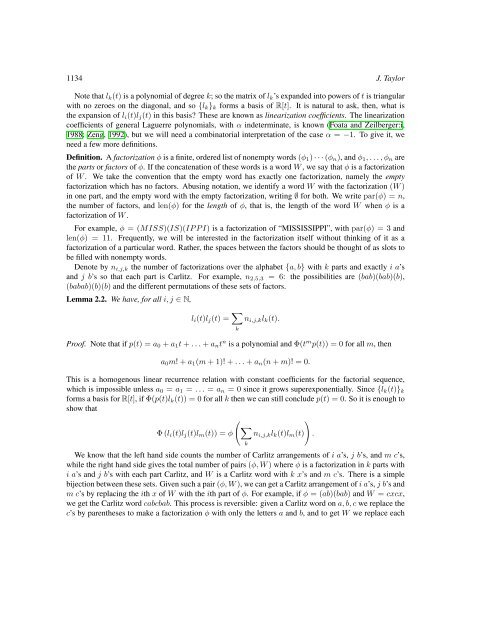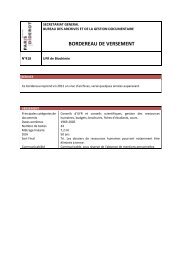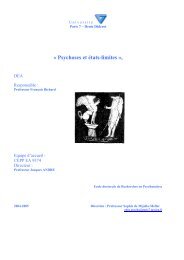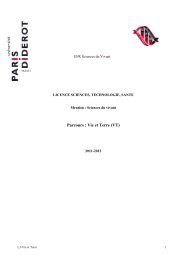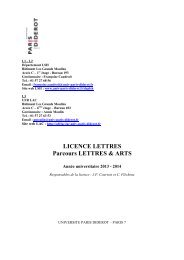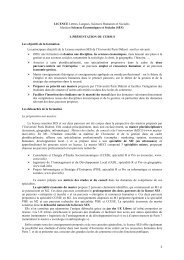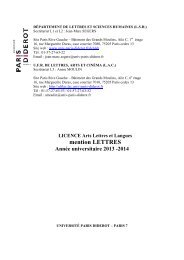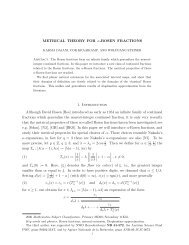Counting words with Laguerre polynomials - liafa
Counting words with Laguerre polynomials - liafa
Counting words with Laguerre polynomials - liafa
Create successful ePaper yourself
Turn your PDF publications into a flip-book with our unique Google optimized e-Paper software.
1134 J. Taylor<br />
Note that l k (t) is a polynomial of degree k; so the matrix of l k ’s expanded into powers of t is triangular<br />
<strong>with</strong> no zeroes on the diagonal, and so {l k } k forms a basis of R[t]. It is natural to ask, then, what is<br />
the expansion of l i (t)l j (t) in this basis These are known as linearization coefficients. The linearization<br />
coefficients of general <strong>Laguerre</strong> <strong>polynomials</strong>, <strong>with</strong> α indeterminate, is known (Foata and Zeilberger:i,<br />
1988; Zeng, 1992), but we will need a combinatorial interpretation of the case α = −1. To give it, we<br />
need a few more definitions.<br />
Definition. A factorization φ is a finite, ordered list of nonempty <strong>words</strong> (φ 1 ) · · · (φ n ), and φ 1 , . . . , φ n are<br />
the parts or factors of φ. If the concatenation of these <strong>words</strong> is a word W , we say that φ is a factorization<br />
of W . We take the convention that the empty word has exactly one factorization, namely the empty<br />
factorization which has no factors. Abusing notation, we identify a word W <strong>with</strong> the factorization (W )<br />
in one part, and the empty word <strong>with</strong> the empty factorization, writing ∅ for both. We write par(φ) = n,<br />
the number of factors, and len(φ) for the length of φ, that is, the length of the word W when φ is a<br />
factorization of W .<br />
For example, φ = (MISS)(IS)(IP P I) is a factorization of “MISSISSIPPI”, <strong>with</strong> par(φ) = 3 and<br />
len(φ) = 11. Frequently, we will be interested in the factorization itself <strong>with</strong>out thinking of it as a<br />
factorization of a particular word. Rather, the spaces between the factors should be thought of as slots to<br />
be filled <strong>with</strong> nonempty <strong>words</strong>.<br />
Denote by n i,j,k the number of factorizations over the alphabet {a, b} <strong>with</strong> k parts and exactly i a’s<br />
and j b’s so that each part is Carlitz. For example, n 2,5,3 = 6: the possibilities are (bab)(bab)(b),<br />
(babab)(b)(b) and the different permutations of these sets of factors.<br />
Lemma 2.2. We have, for all i, j ∈ N,<br />
l i (t)l j (t) = ∑ k<br />
n i,j,k l k (t).<br />
Proof. Note that if p(t) = a 0 + a 1 t + . . . + a n t n is a polynomial and Φ(t m p(t)) = 0 for all m, then<br />
a 0 m! + a 1 (m + 1)! + . . . + a n (n + m)! = 0.<br />
This is a homogenous linear recurrence relation <strong>with</strong> constant coefficients for the factorial sequence,<br />
which is impossible unless a 0 = a 1 = . . . = a n = 0 since it grows superexponentially. Since {l k (t)} k<br />
forms a basis for R[t], if Φ(p(t)l k (t)) = 0 for all k then we can still conclude p(t) = 0. So it is enough to<br />
show that<br />
( )<br />
∑<br />
Φ (l i (t)l j (t)l m (t)) = φ n i,j,k l k (t)l m (t) .<br />
k<br />
We know that the left hand side counts the number of Carlitz arrangements of i a’s, j b’s, and m c’s,<br />
while the right hand side gives the total number of pairs (φ, W ) where φ is a factorization in k parts <strong>with</strong><br />
i a’s and j b’s <strong>with</strong> each part Carlitz, and W is a Carlitz word <strong>with</strong> k x’s and m c’s. There is a simple<br />
bijection between these sets. Given such a pair (φ, W ), we can get a Carlitz arrangement of i a’s, j b’s and<br />
m c’s by replacing the ith x of W <strong>with</strong> the ith part of φ. For example, if φ = (ab)(bab) and W = cxcx,<br />
we get the Carlitz word cabcbab. This process is reversible: given a Carlitz word on a, b, c we replace the<br />
c’s by parentheses to make a factorization φ <strong>with</strong> only the letters a and b, and to get W we replace each


